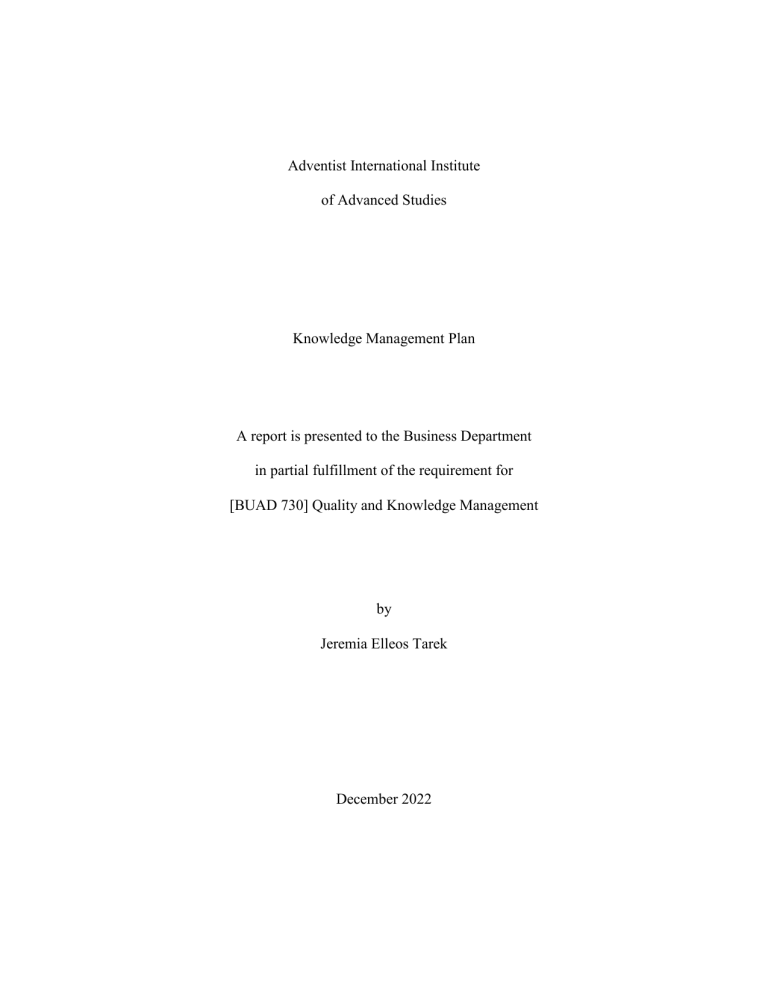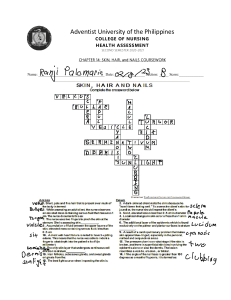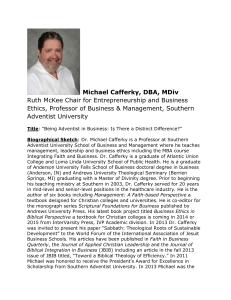
Adventist International Institute of Advanced Studies Knowledge Management Plan A report is presented to the Business Department in partial fulfillment of the requirement for [BUAD 730] Quality and Knowledge Management by Jeremia Elleos Tarek December 2022 A. Knowledge Management Knowledge is everything associated with facts and information that gained through interaction and experiences in real life. It is a duplication of different characteristics and approaches that will enable someone to cope with different challenges. According to Lehmann and Gautler (2019), knowledge has to go through construction and reconstruction process whereas the imagery of a framework is constructed through unlimited encounters that shape someone’s impression towards something. Knowledge is also remains the key to unlock different skills and create pathway to synchronize all human interests into one particular object. “Knowledge is a systematic framework that delineates a demand of product to be foreseen and aligned with expectations” (Clooney, 2017, p. 34). However, it is believed that knowledge is developed by tacit information and theories that underlie the making of its concept. Therefore, there is a need for the knowledge to be translated properly into certain system that can be understood and implemented in a concrete way. Knowledge management is a simultaneous process which a certain party gathers, organizes, shares, and analyzes their information in order to ease the access needed for the employees and other stakeholders as the users. The purpose of knowledge management is to improve organizational efficiency and make the knowledge accessible when needed. Furthermore, knowledge management helps the related stakeholders to acquire, store, share, and review the knowledge they found necessary in order to enhance their tasks (McHart & Gilley, 2016). There are two types of knowledge tacit and explicit knowledge. In tacit knowledge, the transfer of information is determined by the intuitive in nature, personal beliefs, and practices. On the other hand, explicit knowledge is something more tangible in nature, as it can be found in different means such as literatures, websites, databases, and can be extracted where needed. In other words, the knowledge has been codified. B. Knowledge Management Implementation Target Permata Ibu Adventist Academy, Denpasar Bali. Permata Ibu Adventist Academy is a K-9 school which located in Surapati Street IV/6, Denpasar, Bali. The school was established in 1978 by considering the fact that no schools in the island offered any weekday school. The school is divided into three levels: kindergarten, elementary, and junior high school. As an Adventist school that supervised by the parent organization, the school continues to observe the core values inherited from the Bible teachings. Permata Ibu Adventist Academy is currently working on several facility’s renovation as well as teachers’ recruitment. The school accepts students from various background, including nonChristian students. Number of students and operational cost hike have been one of the top concerns in the school. Nevertheless, the school has been receiving donations from the government education funds and organization fund. There are 117 students enrolled in the schools and they are distributed into different levels. In the meantime, there are 12 active teachers and 3 school administrative staffs that work for the school. C. Adopted Knowledge Management Processes/Cycle The researcher has decided to incorporate the knowledge management cycle based on the idea of Meyer and Zack (2006). This model is extracted from the design and development of a product and is meant to be logical and standardized. There are 5 cycles that can be depicted as follows: 1. Acquisition 5. Presentation 2. Refinement KM Cycle of Meyer & Zack (2006) 4. Distribution 3. Store 1. Data Acquisition Acquired knowledge is the one that organizations receive from external sources. External sources play a critical role in representing the full-scale view of the value chain for the organization. It involves the preparation of a knowledge map and encoding them into a knowledge base. Implementing effective knowledge management systems and encouraging a culture of learning and collaboration can help organizations to improve their approach about knowledge acquisition processes. Customers Customer knowledge comes in different forms. Gerbert et al (2002) identify three different types: Knowledge for customer: The knowledge that the customers can gain in order to satisfy their knowledge needs.. It can include product, market, and supplier knowledge. It can be sourced from our company or from other external sources like other customers and competitors (Zanjani 2008). Knowledge about customer: The kind of knowledge that enables us to know the customer better, to understand their motivations, and to address them better. Includes requirements, expectations, and purchasing activities. Knowledge from customer: The kind of knowledge that deals with products, suppliers, and markets. It can be used to improve our products and services. Suppliers Chan (2009) presents a classification for supplier knowledge based on the concepts outlined by Gerbert et al (2002) regarding customer knowledge. These are: Knowledge for suppliers: This is the knowledge that suppliers require and includes "production needs and forecasts, inventory, products, customers, and markets" (Chan 2009). Knowledge about suppliers: This is knowledge that is used to understand how the supplier can match the requirements of the organization; provide insight regarding quality, delivery, defects, financial risks etc. Knowledge from suppliers: This refers to the knowledge that suppliers have gathered from their dealings with the organization. The KM initiatives and the role of IT are similar to the ones presented in the customer segment, with the organization now taking on the role of customer. Knowledge acquisition in this case also includes data and information which can be processed and used as building blocks for new knowledge creation. Gamble and Blackwell (2001) refer to compatible goals, cultural alignment, and leadership commitment amongst the key factors for sustained, productive, long-term relationships. Competitors This deserves mention but it is a fairly straightforward aspect of KM. It simply involves collecting, organizing and presenting the data, information, and knowledge that the firm has acquired in such a way that one can search, retrieve, and analyze it. Some of this falls within the scope of information management, but it is particularly the process of using these components to create better decisions and new knowledge that is of interest here. IT systems are very useful in this case, since the sources are largely explicit and presumably require frequent updating and manipulation. Data mining and analysis, document management systems with suitable search functions, and expert systems are most relevant here. Partners/Alliances Alliances intended to increase knowledge are a valuable potential resource. However these must be properly managed. Key success factors include fostering trust, learning from your partner, and effectively managing the creation of knowledge relevant to both parties. Knowledge transfer can be facilitated by personnel exchanges, common projects and other forms of regular interaction, technology sharing, etc. (Gamble & Blackwell 2001). Focusing on informal communication, collaboration, and socialization is of paramount importance for valuable tacit knowledge acquisition and for extending communities of practice beyond the firm's borders. Chan (2009) once again formulates a set of knowledge types based around the work of Gerbert et al (2002): Knowledge for partners: Knowledge which satisfies their needs, including knowledge about products, markets, and suppliers (Chan 2009). Knowledge about partners: Knowledge acquisition focused on understanding the ability of partners to perform their role in the relationship. Includes distribution channels, products, services, etc. Knowledge from partners: The knowledge that partners have accumulated from dealing with the organization. 2. Refinement Refinement means insert value, reorganization, relabeling and indexing. Refinement is the primary source of value addition. The value addition could be physical (translation of information among various media) or logical form (restructuring, relabeling, indexing, and integrating) which helps in creating more readily usable knowledge objects and which store the contents more flexibly for future use. Refining standardize (conforming to templates of a best practice or lessons learned as used within that particular organization) the primary data by cleaning up (sanitizing content so as to ensure complete anonymity of sources and key players involved) the irrelevant materials. This phase creates value not only through producing usable information, but also through allowing the information to be stored flexibly, in different formats and on different media. Some of the specific processes in this phase involve the analysis, interpretation, integration, synthesis, and standardization of information 3. Storage/Retrieval Storage is a vital stage of this cycle because it creates a connection between the first two stages. That is, it forms a bridge between the upstream acquisition and refinement stages that feed the repository and downstream stages of product generation. It can be physical (file folders, printed information) as well as digital (database), KM software. A system and method for representing, storing and retrieving real-world knowledge on a computer or network of computers is disclosed. Knowledge is broken down into permanent atomic “facts” which can be stored in a standard relational database and processed very efficiently. It also provides for the efficient querying of a knowledge base, efficient inference of new knowledge and translation into and out of natural language. Queries can also be processed with full natural language explanations of where the answers came from. The method can also be used in a distributed fashion enabling the system to be a large network of computers and the technology can be integrated into a web browser adding to the browser's functionality. 4. Distribution Distribution means providing information to users through various media (print, telephone, radio, television, email, fax and letters) and encompasses not only the medium of delivery but also its timing, frequency, form, language, and so on. The warning of this phase is that medium and content are interrelated. The process delivers the product to the end users. Knowledge exchange allows for employees to communicate information within the organization. Additionally, knowledge exchange can allow knowledge to be passed to other organizations. Knowledge distribution can include the sharing of both implicit and explicit knowledge. Explicit knowledge is accessible and generally easy both to share and communicate. Case studies are a well-known explicit knowledge example. Alternatively, implicit knowledge such as organizational culture is demonstrated through actions. The combination of explicit knowledge and implicit knowledge within an organization is referred to as organizational memory. Unfortunately, the organizational memory of a business can be lost. Examples of situations where organization memory is lost could include improper document management or information technology issues. Considering the consequences associated with organizational memory loss, businesses should address data management and information technology issues promptly. Additionally, best practices for data management and information technology would support proactive measures instead of reactivity. D. Proposed Knowledge Management Process a. Inputs: 1.. Boosting Learning Achievements Learning is essentially a conscious effort made by individuals to fulfill their needs. Every learning activity carried out by students will produce changes in themselves. Bloom and colleagues grouped them into cognitive, affective, and psychomotor areas. 2. School Surrounding Environment Utilizing the surrounding environment of the school is a learning approach that seeks to increase student involvement through the use of the environment as a source of learning. This approach assumes that learning activities will attract the attention of students if what is learned is raised from their environment, so that what is learned is related to life and beneficial to the environment. 3. Entrepreneurship Program. At present, many private schools are more advanced and of better quality than public schools, because they are not bound by government funding allocations. This challenges public schools to be able to be independent like private schools. Therefore, school principals must understand the principles of entrepreneurship, then develop and incorporate them into the curriculum. b. Outputs: 1. School Accountability The decentralization of education aims to provide the widest possible authority to schools in managing education. The principle of school-based management refers to giving the widest possible authority to schools. 2. Change of life through positive students’ habit: Education is a lifelong need. Every human being needs education, no matter where or when they are. Education is very important because without education, humans will have difficulty developing and even lagging behind. Therefore, education must be directed properly to produce quality human beings who are able to compete and have good morals and ethics. c. Process: Permata Ibu Adventist Academy, Denpasar Bali, believes on a holistic development that will shape the students for their character development and to shine bright for the community where they are interacted in. Below is the vision, mission, and philosophy of the school: Vision: Each child will be well-equipped with the knowledge and abilities to “do the right thing” and the relationship skills to “do the kind thing.” He or she will remain teachable throughout life and truly “follow Jesus.” Mission: To bless children and community – Permata Ibu Adventist Academy, Denpasar provides a strong academic program with valuable enrichments in a Seventh-day Adventist context. Philosophy: Educating young people at the elementary school level provides the foundational opportunity to shape how students see, live in, and relate to the world around them. At Rogers School, students are encouraged to relate to a world that needs godly people who think clearly, live responsibly, act nobly, and love generously, even as they plan for eternity. E. Proposed Instrument for Process 1. School Benchmarking Benchmarking is suitable for institutions of higher education. Benchmarking will help to overcome resistance to change, provide a structure for external evaluation, and create new networks of communication between schools where valuable information and experiences on teaching and research can be shared. Benchmarking data helps educators and school administrators to reform or realign both their administrative processes as well as the way that they structure their lessons. Global benchmarking has also opened the door for schools to collaborate with each other with the establishment of effective communication networks. 2. School Survey Surveys have manifold benefits. They help enhance the efficiency of course structure, provide insights into the levels of student satisfaction, and act as a means whereby students can share their experiences in a transparent manner. They provide teachers the ability to make modifications to their teachings in real-time. Additionally, schools/colleges can send questionnaires to parents at home for a deeper understanding of their student's habits and their home environment 3. Financial Support Operational funding covers a school’s running costs, including the wages of all nonteaching staff, property maintenance, classroom materials, purchase and depreciation of capital items, leases and rentals and staff professional development. Operational funding is calculated using school rolls and other factors such as decile. It is responsive to roll fluctuations. The ministry pays it directly into your school’s bank account every three months. The amount of the quarterly payments varies across the year. 4. Church The church considers its responsibility to open the minds and souls of men and women to the depth dimensions of their humanity and to the realities of the material world around them. The Church is committed to a search for Truth and knowledge and the tool it can use best for this is the tool of systematic education. F. Proposed Position 1. School Administrators Administrators are responsible for providing administrative support for an office or department within a school. They play a crucial role in the day-to-day life of a school by providing a wide range of administrative support to keep everything running as smoothly as possible. 2. School Facilities The management of a school’s facility – e.g., the condition of buildings, the availability of teaching equipment, and the overall safety of the teaching environment – has a direct impact on the outcome of education provided by staff to pupils. A well-maintained facility is directly associated with higher student achievement. A school building that is free from disruption increases teaching time and reduces teacher turnover by 25% (Graham, 2018). 3. Teachers The primary role of a teacher is to deliver classroom instruction that helps students learn. To accomplish this, teachers must prepare effective lessons, grade student work and offer feedback, manage classroom materials, productively navigate the curriculum, and collaborate with other staff. Absorbing knowledge through a thorough classroom management is the linchpin that makes teaching and learning achievable in the teaching learning process. It is the teacher who plays the main role in planning, organizing procedures and resources, arranging the environment to maximize efficiency, monitoring students' progress, anticipating potential problems. 4. Parents The need for a strong partnership between schools and families to educate children may seem like common sense. In simpler times, this relationship was natural and easy to maintain. Teachers and parents were often neighbors and found many occasions to discuss a child's progress. Children heard the same messages from teachers and parents and understood that they were expected to uphold the same standards at home and at school. Knowledge gained from the parents will help the school to develop and thrive through their inputs and continuous dynamics. G. Conclusion Seventh-day Adventist School must become center of knowledge creating, delivering, and learning for society. On international level, knowledge sharing policies between two and more countries are going on. For the development of nation it is must. Discussions and exchange of information is very common among staff, students and scholars now days. This is the base for the generation of innovative concepts. Through open access movement everyone is able to access the information through internet. But at local and institutional level attempts are required for capturing tacit knowledge of individuals and sharing for new vision and mission. Knowledge Management is a vital and effective tool in educational organizations and it can be applied in the school environment.



